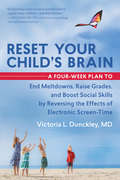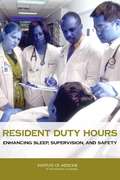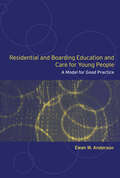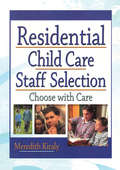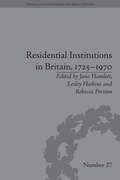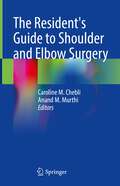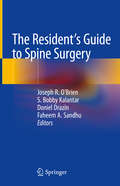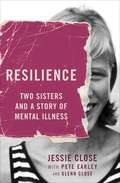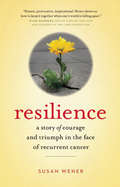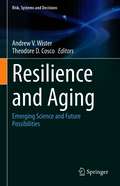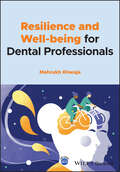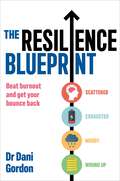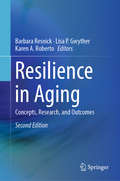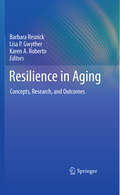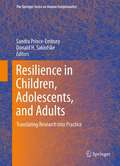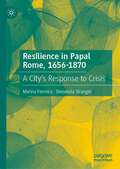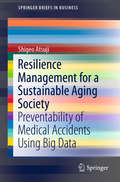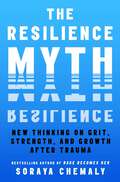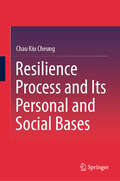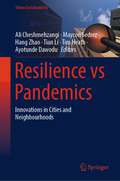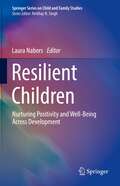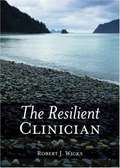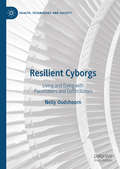- Table View
- List View
Reset Your Child's Brain: A Four-Week Plan to End Meltdowns, Raise Grades, and Boost Social Skills by Reversing the Effects of Electronic Screen-Time
by Victoria L. Dunckley, MDIncreasing numbers of parents grapple with children who are acting out without obvious reason. Revved up and irritable, many of these children are diagnosed with ADHD, bipolar illness, autism, or other disorders but don’t respond well to treatment. They are then medicated, often with poor results and unwanted side effects. Based on emerging scientific research and extensive clinical experience, integrative child psychiatrist Dr. Victoria Dunckley has pioneered a four-week program to treat the frequent underlying cause, Electronic Screen Syndrome (ESS). Dr. Dunckley has found that everyday use of interactive screen devices — such as computers, video games, smartphones, and tablets — can easily overstimulate a child’s nervous system, triggering a variety of stubborn symptoms. In contrast, she’s discovered that a strict, extended electronic fast single-handedly improves mood, focus, sleep, and behavior, regardless of the child’s diagnosis. It also reduces the need for medication and renders other treatments more effective. Offered now in this book, this simple intervention can produce a life-changing shift in brain function and help your child get back on track — all without cost or medication. While no one in today’s connected world can completely shun electronic stimuli, Dr. Dunckley provides hope for parents who feel that their child has been misdiagnosed or inappropriately medicated, by presenting an alternative explanation for their child’s difficulties and a concrete plan for treating them.
Resident Duty Hours: Enhancing Sleep, Supervision, and Safety
by Institute of Medicine of the National AcademiesMedical residency in the United States aims to prepare recent medical school graduates to practice medicine independently. One fundamental requirement of resident education is in-depth, firsthand experience caring for patients. During the three to seven years of training, residents often work long hours with limited time off to catch up on their sleep. They can experience fatigue on the job, contributing to increased errors and accidents. However, many medical educators believe extensive duty hours are essential to provide residents with the educational experiences they need to become competent in diagnosing and treating patients. Resident Duty Hours: Enhancing Sleep, Supervision, and Safety, a December 2008 report from the IOM, asserts that revisions to medical residents' workloads and duty hours are necessary to better protect patients against fatigue-related errors and to enhance the learning environment for doctors in training. The report recommends that residency programs provide regular opportunities for sleep each day and each week during resident training. In addition, it recommends that the Accreditation Council for Graduate Medical Education provide better monitoring of duty hour limits and that residency review committees set guidelines for residents' patient caseload. Patient handover procedures and supervision of residents should also be strengthened. Until these changes take place, residency programs are not providing what the next generation of doctors or their patients deserve.
Residential and Boarding Education and Care for Young People: A Model for Good Management and Practice
by Ewan AndersonThis innovative book identifies the key elements of good management and practice common to all residential child care settings - whether hospital unit, boarding school, children's home, special school or custodial care establishment - and important variations between the different settings. Using a model developed under the auspices of the Rowntree Foundation, it provides managers with a coherent framework for understanding the different facets of their role and the outcomes they are aiming to achieve. Major components of the model are:· the environment· the legal framework· developmental issues· time-related issues.In each case the salient factors for practice and management are identified and discussed. Good Practice Education and Residential Care of Children offers a model which can be readily applied to training, assessment of standards, inspections, and research and development. Based on the latest research and reflecting the national drive towards evidence-based standards, it will be an invaluable support to managers in training and practice.
Residential Child Care Staff Selection: Choose with Care
by Meredith KiralyHere's vital information on making the right recruitment choices, getting the best staff, and avoiding potential abusers! "More than a set of procedures, good staff selection practice is about a set of principles that embody particular attitudes to the task. If we achieve these basic principles, we will go a long way towards eliminating selection errors and the risk of abuse that follows such errors." -Author Meredith Kiraly Residential Child Care Staff Selection: Choose With Care draws upon international research and the experience of practitioners to help you improve your ability to recruit the best staff. With a minimum of jargon, this book covers the range of selection methods and advocates a considered-but not cumbersome-approach that uses more than one method of assessing skills. It illustrates management techniques that reduce the likelihood of abuse and will show you how to avoid recruiting potentially abusive individuals. Residential Child Care Staff Selection: Choose With Care provides insightful background information, examining the developmental needs of children; issues in the care of children away from home; abuse and pedophilia; and legal and ethical issues. Then the book discusses in more detail research findings which underpin key principles of good care and good staff selection, and best practice in a range of recruitment and selection practices. You'll also find a recruitment guide for all organizations that work with children and young people. The recruitment guide thoroughly examines the challenges and pitfalls of the recruitment process and will help you identify those who are most fit for this difficult yet extraordinarily rewarding career, and avoid recruiting those most likely to be abusive. This valuable book also includes four helpful appendixes that provide: examples of situational and behavioral questions to use in interviews Equal Employment Opportunity guidelines for acceptable and unacceptable interview questions a profile of a skilled residential child care worker that you can use to judge whether candidates measure up sample staff selection forms-job descriptions, application form, a short-listing grid, job interview schedule, interview performance rating form, a reference check proforma, and a selection report
Residential Fire Safety: An Interdisciplinary Approach (The Society of Fire Protection Engineers Series)
by Marcus Runefors Ragnar Andersson Mattias Delin Thomas GellThis book provides a comprehensive overview of deaths and injuries from residential fires as well as the most up to date information on evidence-based approaches to reduce this problem. The volume serves as a guide for professionals working in the field of fire prevention and as a textbook for instruction in universities and fire service schools. The authors’ interdisciplinary approach, where public health methodology is combined with fire protection engineering, medicine, and policy science, is quite distinctive outside of the technical literature devoted to larger scale fire events. Traditional textbooks on fire protection tend to describe the problem as purely technical, whereas in essence it is a problem of human vulnerability. In this book, readers will find lucid and rigorous descriptions of various risk groups and effective preventive measures that are effective, both in general and with respect to the different risk groups. They will also find work processes to facilitate risk reduction. Summarizing state-of-the-art knowledge and giving guidance for the future, both in terms of preventive efforts and ongoing research, Residential Fire Safety: An Interdisciplinary Approach, is ideal for students, educators, and practitioners of residential fire protection.
Residential Institutions in Britain, 1725–1970: Inmates and Environments (Perspectives in Economic and Social History #27)
by Jane HamlettThe essays in this collection explore both organizational intentions and inhabitants' experiences in a diverse range of British residential institutions during a period when such provision was dramatically increasing.
The Resident's Guide to Shoulder and Elbow Surgery
by Caroline M. Chebli Anand M. MurthiUtilizing a practical, high-yield presentation, this textbook is a comprehensive review of the most common shoulder and elbow diagnoses and management strategies. It allows easy access to pertinent information for residents and fellows while preparing for rounds, the clinic and the operating room and also aides residents studying for their yearly in-training exam (OITE). Each topic is organized in a consistent, bulleted format so that the information flows in a logic manner: history, physical examination, imaging (when and what to order), and the most appropriate treatment algorithm. The most common classification systems are emphasized and illustrated, and treatment algorithms are further organized into non-operative and operative and include surgical approaches as well as the risks and complications of surgical intervention. The shoulder and elbow are covered in their own exclusive sections, with each chapter discussing the unique diagnostic considerations for each anatomic structure and the types of injuries to expect. Topics in the shoulder section include osteoarthritis, rotator cuff arthropathy and tears, instability, stiffness, SLAP tears and biceps tendinitis, and fractures of the clavicle and scapula. Topics in the elbow section include biceps and triceps rupture, lateral and medical epicondylitis, instability and stiffness, and elbow fractures - distal humerus, Monteggia, the terrible triad and more. Case material, key points and takeaways, and question-and-answer elements are included to enhance the text's overall utility. There is currently no textbook on the shoulder and elbow tailored specifically for orthopedic residents, fellows and senior medical students. The Resident's Guide to Shoulder and Elbow Surgery therefore provides a much-needed resource for early-career clinicians and surgeons.
The Resident's Guide to Spine Surgery
by Joseph R. O’Brien S. Bobby Kalantar Doniel Drazin Faheem A. SandhuWith an emphasis on set-up and execution and lessons learned from expert practitioners, this concise, practical guide for residents and fellows presents the essentials for both common and complex spine surgery. Proceeding anatomically from the cervical to the sacroiliac, and including chapters on spinal tumors, infection and revision surgery, nearly 40 different procedures are highlighted, from corpectomy, arthroplasty and laminectomy to percutaneous screws, decompression and fusion. Chapters include all the information a resident will need to know: indications and contraindications, imaging and diagnosis, OR set-up and instrumentation selection, the specific operative technique, post-operative protocols, and clinical pearls and pitfalls. Radiographs and full-color intraoperative photographs accompany each procedure. Whether suturing dura or performing a lateral interbody fusion, spinal surgery is a technical pursuit, and having a firm grasp of the details can ultimately determine the procedure's success. Written and edited by veterans in orthopedic surgery and neurosurgery, The Resident's Guide to Spine Surgery is just the detailed, user-friendly resource for up-and-coming clinicians looking to develop and expand their surgical expertise.
Resident's Handbook of Medical Quality and Safety
by Levi Levan AtanelovDrive to provide high value healthcare has created a field of medical quality improvement and safety. A Quality Improvement (QI) project would often aim in translate medical evidence (e. g. hand hygiene saves lives) into clinical practice (e. g. actually washing your hands before you see the patient, suffice it to say that not all hospitals are able to report 100% compliance with hand-hygiene). All doctoral residents in the United States must now satisfy a new requirement from the American College of Graduate Medical Education that they participate in a QI initiative. However, few departments are equipped to help their residents develop and implement a QI initiative. Resident's Handbook is a short, not fussy, and practical introduction to developing a QI initiative. Meant not only for residents seeking to jump-start a QI initiative but also for attending physicians looking to improve their clinical practice, residency program directors and even medical students already eyeing what residency training holds for them; the book introduces and explains the basic tools needed to conduct a QI project. It provides numerous real-life examples of QI projects by the residents, fellows and attendings who designed them, who discuss their successes and failures as well as the specific tools they used. Several chapters provide a more senior perspective on resident involvement in QI projects and feature contributions from several QI leaders, a hospital administration VP and a residency program director. Though originally designed with physicians in mind, the book will also be helpful for physician assistants, nurses, physical, occupational and speech language pathology therapists, as well as students in these disciplines. Since no QI intervention is likely to be successful if attempted in isolation more non-physician clinicians are joining the ranks of quality and safety leadership. Therefore several non-physician clinician led initiatives included in the manuscript constitute an integral part of this book. The book serves as a short introduction to the field of medical quality improvement and safety emphasizing the practical pointers of how to actually implement a project from its inception to publication. To our knowledge this is the first concise do-it-yourself publication of its kind. Some of the topics covered include: how to perform an efficient literature search, how to get published, how to scope a project, how to generate improvement ideas, effective communication, team, project management and basic quality improvement tools like PDCA, DMAIC, Lean, Six Sigma, human factors, medical informatics etc. . Although no substitute for the services of a trained clinical statistician, chapters on statistics and critical assessment of the medical literature familiarizes residents with basic statistical methodologies, clinical trials and evidence based medicine (EBM). Since no QI project is complete without providing evidence for post-intervention improvement we provide a short introduction to the free statistical language R, which helps residents independently run basic statistical calculations. Because much of QI involves assessment of subjective human experiences, there is also a chapter on how to write surveys. Resident's Handbook of Medical Quality and Safety is not an exhaustive QI textbook but rather a hands-on pocket guide to supplement formal training by other means.
Resilience: Two Sisters and a Story of Mental Illness
by Pete Earley Glenn Close Jessie CloseAt a young age, Jessie Close struggled with symptoms that would transform into severe bipolar disorder in her early twenties, but she was not properly diagnosed until the age of fifty. Jessie and her three siblings, including actress Glenn Close, spent many years in the Moral Re-Armament cult. Jessie passed her childhood in New York, Switzerland, Connecticut, Zaire (now the Democratic Republic of Congo), and finally Los Angeles, where her life quickly became unmanageable. She was just fifteen years old.Jessie's emerging mental illness led her into a life of addictions, five failed marriages, and to the brink of suicide. She fought to raise her children despite her ever worsening mental conditions and under the strain of damaged romantic relationships. Her sister Glenn and certain members of their family tried to be supportive throughout the ups and downs, and Glenn's vignettes in RESILIENCE provide an alternate perspective on Jessie's life as it began to spiral out of control. Jessie was devastated to discover that mental illness was passed on to her son Calen, but getting him help at long last helped Jessie to heal as well. Eleven years later, Jessie is a productive member of society and a supportive daughter, mother, sister, and grandmother. In RESILIENCE, Jessie dives into the dark and dangerous shadows of mental illness without shying away from its horror and turmoil. With New York Times bestselling author and Pulitzer Prize finalist Pete Earley, she tells of finally discovering the treatment she needs and, with the encouragement of her sister and others, the emotional fortitude to bring herself back from the edge.
Resilience
by Susan WenerSusan Wener survived cancer not once, but twice. The first time she followed the traditional route of surgery and chemotherapy. The second she went renegade, stepping out into the field of alternative medicine. This book brings to life a journey of more than 30 years, years filled with joy, as well as incredible physical, psychological, and spiritual challenges. As an educator and therapist who helps individuals cope with life-threatening illness, Wener brings a unique perspective to this story. As both a therapist and a patient, she discovers that what is most successful is medical care that is integrated, taking the whole patient into account, not just the disease in isolation. In prose that is both funny and profoundly moving, Wener takes us on her extraordinary journey to wellness and wisdom. She shares her innermost feelings with honesty, insight, and humor. She reminds us that life is filled with endless possibility, that hope and wishful thinking not only help us keep our heads above water but are essential to our sanity, and that what makes us magic is our ability to pick ourselves up every time we fall.
Resilience and Aging: Emerging Science and Future Possibilities (Risk, Systems and Decisions)
by Andrew V. Wister Theodore D. CoscoOlder aged adults face many adversities over the later life course. This edited volume will address the ways in which seniors bounce back from different types and combinations of adversity – termed “resilience”. While research has been accumulating that identifies inherent abilities and external resources needed to adapt and navigate stress-inducing experiences among aging and older adults, gaps remain in understanding the unique elements and processes of resilience. A series of chapters included in this book will address several overarching questions: why do some older individuals/families/communities adapt to adversity better than others; what are modifiable behavioral protective/risk factors related to resilience; and how can we foster resilience at the individual/community level and which approaches show the most promise?The spectrum of aging-related challenges and responses addressed in this book include: mental health; physical/functional health problems; multimorbidity; socio-economic deprivation; social isolation and loneliness; cultural dimensions of loneliness; housing/homelessness problems; and environmental disasters. This book presents cutting-edge science at the conceptual, methodological, empirical and practice levels applied to emerging resilience sub-fields in gerontology. It will also present potential areas of future research, policy and practice linked to these areas.During a period of the most rapid population aging in the US, Canada and many other nations, coupled with heightened global socio-political change, extending our knowledge of resilience will help society to make important adjustments to maximize health and wellness of older individuals. Supporting and enhancing resilience through technological, social and/or community-level advances in geroscience will help those facing adversity to thrive by harnessing, stretching, and leveraging a wide array of potential resources. The promotion of healthier older populations has far-reaching consequences for health care and social/community support systems, both in terms of public health including pandemic response, and the development and implementation of innovations in treatment and practice guidelines.
Resilience and Well-being for Dental Professionals
by Mahrukh KhwajaResilience and Well-being for Dental Professionals Essential reading for dental professionals and other healthcare workers wanting to build emotional resilience and positive mental health Dentistry is a high-stress profession with elevated rates of anxiety, depression, burnout, suicidal thoughts and self-harm. Chronic workplace stress is a growing concern as it can severely damage the mental health of dental professionals and negatively impact their ability to provide appropriate care. Psychological interventions have been shown to greatly benefit the well-being and emotional resilience of the medical and healthcare community, yet resources that provide preventative tools are limited. Resilience and Well-being for Dental Professionals, is designed not only to combat occupational hazards in Dentistry, such as burnout and compassion fatigue, but also to build resilience, engagement at work and nurture positive mental health through a variety of evidence-based tools. This invaluable guide helps readers utilise tools from the science of well-being (Positive Psychology, Mindfulness, Cognitive Behavioural Therapy and Acceptance and Commitment Therapy), to create happier, thriving careers. It includes: Tools from resilience interventions to help dental professionals implement preventative habits and take steps towards positive mental health Focus on self awareness in recognizing burnout early Positive psychology and well-being exercises, customised for dental professionals, to help you meld together research and application: from journaling and creative exercises to nature-based and activities at work Measure and track well-being using psychological scales Manage difficult emotions, practice mindfulness and self-compassion, develop a culture of kindness and gratitude at work, utilise a growth mindset when upskilling, harness positive leadership and use strengths, with patients and at home Create habits that stick through applying the psychology of goal setting, behaviour change, motivation psychology, work-life harmony and happiness Written by a Positive Psychologist, and Dentist, with more than 12 years’ clinical dentistry experience within a stressful NHS environment, Resilience and Well-being for Dental Professionals is a must-have resource for all dental students, hygienists, therapists, dentists, dental nurses, dental technicians, specialists and allied healthcare workers.
The Resilience Blueprint: Beat burnout and get your bounce back
by Dr Dani GordonYou're never too unhealthy, too tired or too late to become the most dynamic, energetic and resilient version of yourselfWe'd all like to be able to bounce back from life's inevitable setbacks, whether those are health issues or emotional challenges. And perhaps we're resilient in one area, such as never catching colds, but not in another, such as we're constantly feeling overwhelmed and anxious. That's because each of us has a resilience type, and if you're not aware of yours, all of your efforts to be healthy may be failing to make a difference. Even the most up to date health advice may not be right for you if it's wrong for your type.Find out if you're a highly strung WOUND-UP WARRIOR, an emotional MOODY WARRIOR, a drained EXHAUSTED WARRIOR, or an easily distracted SCATTERED WARRIOR. Integrative functional medicine doctor Dani Gordon will guide you to identify your personal resilience type, and then offer all the scientifically backed health advice you need to put her transformative 8-week resilience programme into action.This empowering and compassionate guide gives you not just the tools, but the confidence to change your life.
Resilience in Aging: Concepts, Research, and Outcomes
by Barbara Resnick Lisa P. Gwyther Karen A. RobertoThis updated and expanded second edition of Resilience in Aging offers a comprehensive description of the current state of knowledge with regard to resilience from physiological (including genetic), psychological (including cognitive and creative), cultural, and economic perspectives. In addition, the book considers the impact of resilience on many critical aspects of life for older adults including policy issues, economic, cognitive and physiological challenges, spirituality, chronic illness, and motivation. The only book devoted solely to the importance and development of resilience in quality of life among older adults, Resilience in Aging, 2nd Edition continues to offer evidence-based theory, clinical guidelines, and new and updated case examples and real-world interventions so professional readers can make the best use of this powerful tool. The critical insights in this volume are concluded with a discussion of future directions on optimizing resilience and the importance of a lifespan approach to the critical component of aging. The book’s coverage extends across disciplines and domains, including: Resilience and personality disorders in older age.Cultural and ethnic perspectives on enhancing resilience in agingSustained by the sacred: religious and spiritual factors for resilience in adulthood and aging.Building resilience in persons with early-stage dementia and their care partners.Interdisciplinary geriatric mental health resilience interventions.Developing resilience in the aged and dementia care workforce.Using technology to enhance resilience among older adults. This wide-ranging and updated lifespan approach gives Resilience in Aging, 2nd Edition particular relevance to the gamut of practitioners in gerontology and geriatrics, including health psychologists, neuropsychologists, clinical psychologists, psychiatrists, social workers, geriatricians, family physicians, nurses, occupational and physical therapists, among others.
Resilience in Aging
by Karen A. Roberto Barbara Resnick Lisa P. GwytherThe many significant technological and medical advances of the 21st century cannot overcome the escalating risk posed to older adults by such stressors as pain, weakness, fatigue, depression, anxiety, memory and other cognitive deficits, hearing loss, visual impairment, isolation, marginalization, and physical and mental illness. In order to overcome these and other challenges, and to maintain as high a quality of life as possible, older adults and the professionals who treat them need to promote and develop the capacity for resilience, which is innate in all of us to some degree. The purpose of this book is to provide the current scientific theory, clinical guidelines, and real-world interventions with regard to resilience as a clinical tool. To that end, the book addresses such issues as concepts and operationalization of resilience; relevance of resilience to successful aging; impact of personality and genetics on resilience; relationship between resilience and motivation; relationship between resilience and survival; promoting resilience in long-term care; and the lifespan approach to resilience. By addressing ways in which the hypothetical and theoretical concepts of resilience can be applied in geriatric practice, Resilience in Aging provides inroads to the current knowledge and practice of resilience from the perspectives of physiology, psychology, culture, creativity, and economics. In addition, the book considers the impact of resilience on critical aspects of life for older adults such as policy issues (e.g., nursing home policies, Medicare guidelines), health and wellness, motivation, spirituality, and survival. Following these discussions, the book focuses on interventions that increase resilience. The intervention chapters include case studies and are intended to be useful at the clinical level. The book concludes with a discussion of future directions in optimizing resilience in the elderly and the importance of a lifespan approach to aging.
Resilience in Children, Adolescents, and Adults
by Donald H. Saklofske Sandra Prince-EmburyResilience in Children, Adolescents, and Adults: Translating Research into Practice recognizes the growing need to strengthen the links between theory, assessment, interventions, and outcomes to give resilience a stronger empirical base, resulting in more effective interventions and strength-enhancing practice. This comprehensive volume clarifies core constructs of resilience and links these definitions to effective assessment. Leading researchers and clinicians examine effective scales, questionnaires, and other evaluative tools as well as instructive studies on cultural considerations in resilience, resilience in the context of disaster, and age-appropriate interventions. Key coverage addresses diverse approaches and applications in multiple areas across the lifespan. Among the subject areas covered are: - Perceived self-efficacy and its relationship to resilience. - Resilience and mental health promotion in the schools. - Resilience in childhood disorders. - Critical resources for recovering from stress. - Diversity, ecological, and lifespan issues in resilience. - Exploring resilience through the lens of core self-evaluation. Resilience in Children, Adolescents, and Adults is an important resource for researchers, clinicians and allied professionals, and graduate students in such fields as clinical child, school, and developmental psychology, child and adolescent psychiatry, education, counseling psychology, social work, and pediatrics.
Resilience in Papal Rome, 1656-1870: A City's Response to Crisis
by Marina Formica Donatella StrangioThis book analyses the evolution of the city of Rome, in particular, papal Rome, from the plague of 1656 until 1870 when it became the capital of the Kingdom of Italy. The authors explore papal Rome as a resilient city that had to cope with numerous crises during this period. By focusing on a selection of different crises in Rome, the book combines cultural, political, and economic history to examine key turning points in the city’s history. The book is split into chapters exploring themes such as diplomacy and international relations, disease, environmental disasters, famine, public debt, and unravels the political, economic, and social consequences of these transformative events. All the chapters are based on untapped original sources, chiefly from the State Archive in Rome, the Vatican Archives, the Rome Municipal Archives, the École Française Library, the National Library, and the Capitoline Library.
Resilience Management for a Sustainable Aging Society: Preventability of Medical Accidents Using Big Data (SpringerBriefs in Business)
by Shigeo AtsujiThis book utilizes big data to undertake a cluster analysis of medical accidents. Highlighting shared worldwide accident patterns, it represents a first step toward reducing the incidence of accidents through kaizen innovation driven by information and communications technology. This initiative comes against a background where medical accidents are currently the third largest cause of death after heart attack and cancer, making accident prevention an urgent concern. With the objective of preventing these accidents, which negatively impact numerous different stakeholders, and based on interdisciplinary research, the book examines (1) the application of data mining to identify shared accident patterns; (2) proposals for system improvement and organizational innovation aimed at risk and resilience in crisis management; and (3) the use of a global platform to achieve sustainability in the Internet of Medicine (IoM).
The Resilience Myth: New Thinking on Grit, Strength, and Growth After Trauma
by Soraya ChemalyThe author of the &“must-read&” (NPR) Rage Becomes Her presents a powerful manifesto for communal resilience based on in-depth investigations into history, social science, and psychology.We are often urged to rely only on ourselves for strength, mental fortitude, and positivity. But with her distinctive &“skill, wit, and sharp insight&” (Laura Bates, author of Girl Up), Soraya Chemaly challenges us to adapt our thinking about how we survive in a world of sustained, overlapping crises. It is interdependence and nurturing relationships that truly sustain us, she argues. Based on comprehensive research and eye-opening examples from real-life, The Resilience Myth offers alternative visions of relational hardiness by emphasizing care for others and our environments above all.
Resilience Process and Its Personal and Social Bases
by Chau Kiu CheungThis book is to elucidate personal and social bases for personal resilience, thus addressing the issue concerning the predominance of social factors in shaping resilience. Essentially, the book starts with a clarification of resilience as a phenomenon rather than a trait. The clarification also identifies the personal bases in terms of the resilience process, which specifies belief about resilience as a precursor to learning about resilience, action for resilience, and resilience successively. To justify the personal and social bases, the book expounds the analytical-functionalist framework to specify voluntaristic and deterministic mechanisms to perform the four requisite functions of goal attainment, adaptation, integration, and latency. Equipped with the conceptual and theoretical grounds, the book proceeds to scrutinize the effects of personal and social factors on resilience and its process. The personal factors include personal background characteristics, personality, functional disability, and various beliefs, whereas the social factors include experiences of caring, peace, violence, and social exclusion in society, kindness, sociability, and aid from other people, and social capital. The scrutiny engages five databases about 6.948 Chinese people in Hong Kong and neighboring Chinese cities, composed of the public, service users, older adults, students, and people with visual impairment. Overall, the book presents ample theoretical and empirical substances to clarify the genesis of resilience.
Resilience vs Pandemics: Innovations in Cities and Neighbourhoods (Urban Sustainability)
by Ali Cheshmehzangi Maycon Sedrez Hang Zhao Tian Li Tim Heath Ayotunde DawoduThe COVID-19 pandemic and other highly transmissible diseases outbreaks have given a new significance to the concept of “resilience”, placing it in the spotlight of built environment-related studies. New directions have emerged from expanding on adaptive planning, urban layouts, urban morphologies, spatial planning, healthy cities, etc. To enhance resilience in the post-pandemic era, various theories, practices, and hypotheses are being formulated by scholars around the world.For this book project, we invite chapter proposals that provide forefront discoveries about the built environment resilience during and after the ongoing pandemic. Historical perspectives of resilience and other highly transmissible diseases are also relevant to understanding the COVID-19 issues. The authors are encouraged to elaborate on critical exploratory, innovative, and cutting-edge research approaches, highlighting the effects of COVID-19 and other highly transmissible diseases in the design, planning, and perception of the built environment. We aim to gather scientific experiences, reviews, analyses, discussions, recommendations, and solutions in the fields of urban planning, urban design, urban management, environmental science, architecture, etc.The book aims to document resilience-related innovations and new perspectives for the built environment, how people’s interactions adapt to new realities, and which mechanisms, tools, and strategies are required for such transformations in the following two scales of the built environments:(1) City/district; research on planning, commuting and mobility, politics, urban configurations, regulations, transmission and prevention, models, top-down processes, innovation processes, etc.(2) Community/neighborhood; research on collaboration, transmission and prevention, isolation and quarantine, social aspects, accessibility to services, technologies, education, policies, and innovative solutions.The book covers a wide range of studies, including physical and non-physical studies, which may refer to the city infrastructure, green/blue spaces, housing, policy-making, health services, social and economic issues, etc. The findings and results contribute to the decision-making of governments, organizations, and institutions, as well as inspire scholars and future research for developing resilience in the post-pandemic era.
Resilient Children: Nurturing Positivity and Well-Being Across Development (Springer Series on Child and Family Studies)
by Laura NaborsThis book examines resilience in childhood, focusing on positive functioning and development, often in the face of everyday difficulties and adversities. It highlights critical areas in which children and their families can demonstrate resilience and attain positive social, emotional, academic, and behavioral life trajectories. The book describes key factors related to enhancing resilience for children, such as positive relationships with adults, positive school environments, and meaningful connections with others. It provides practical guidelines for promoting resilience in youth and reviews the critical nature of resilience across various situations, critical issues, and different developmental periods. It offers guidance on strategies for fostering resilience in children.Key topics featured include:Raising children to have grit and tenacity.Fostering resilience in children at school and within their families.Nurturing resilience in children with chronic illnesses and posttrauma.Resilient Children is an essential resource for researchers, professors, and graduate students as well as clinicians, therapists, and other professionals in developmental, clinical, and school psychology, family studies, public health, and social work as well as all related disciplines, including educational psychology, child and adolescent psychiatry, and pediatrics.
The Resilient Clinician
by Robert J. WicksThis immensely readable book also includes one of the most current selective bibliographies of relevant research and clinical and theoretical publications in the subject area, from common stressors and vicarious post-traumatic stress disorders to burnout and compassion fatigue.
Resilient Cyborgs: Living and Dying with Pacemakers and Defibrillators (Health, Technology and Society)
by Nelly OudshoornThis book examines how pacemakers and defibrillators participate in transforming life and death in high-tech societies. In both popular and medical accounts, these internal devices are often portrayed as almost magical technologies. Once implanted in bodies, they do not require any ‘user’ agency. In this unique and timely book, Nelly Oudshoorn argues that any discourse or policy assuming a passive role for people living with these implants silences the fact that keeping cyborg bodies alive involves their active engagement. Pacemakers and defibrillators not only act as potentially life-saving technologies, but simultaneously transform the fragility of bodies by introducing new vulnerabilities. Oudshoorn offers a fascinating examination of what it takes to become a resilient cyborg, and in the process develops a valuable new sociology of creating ‘resilient’ cyborgs.
